ESP TOYOTA RAV4 HYBRID 2020 Warranties & Maintenance Guides (in English)
[x] Cancel search | Manufacturer: TOYOTA, Model Year: 2020, Model line: RAV4 HYBRID, Model: TOYOTA RAV4 HYBRID 2020Pages: 260, PDF Size: 8.54 MB
Page 7 of 260
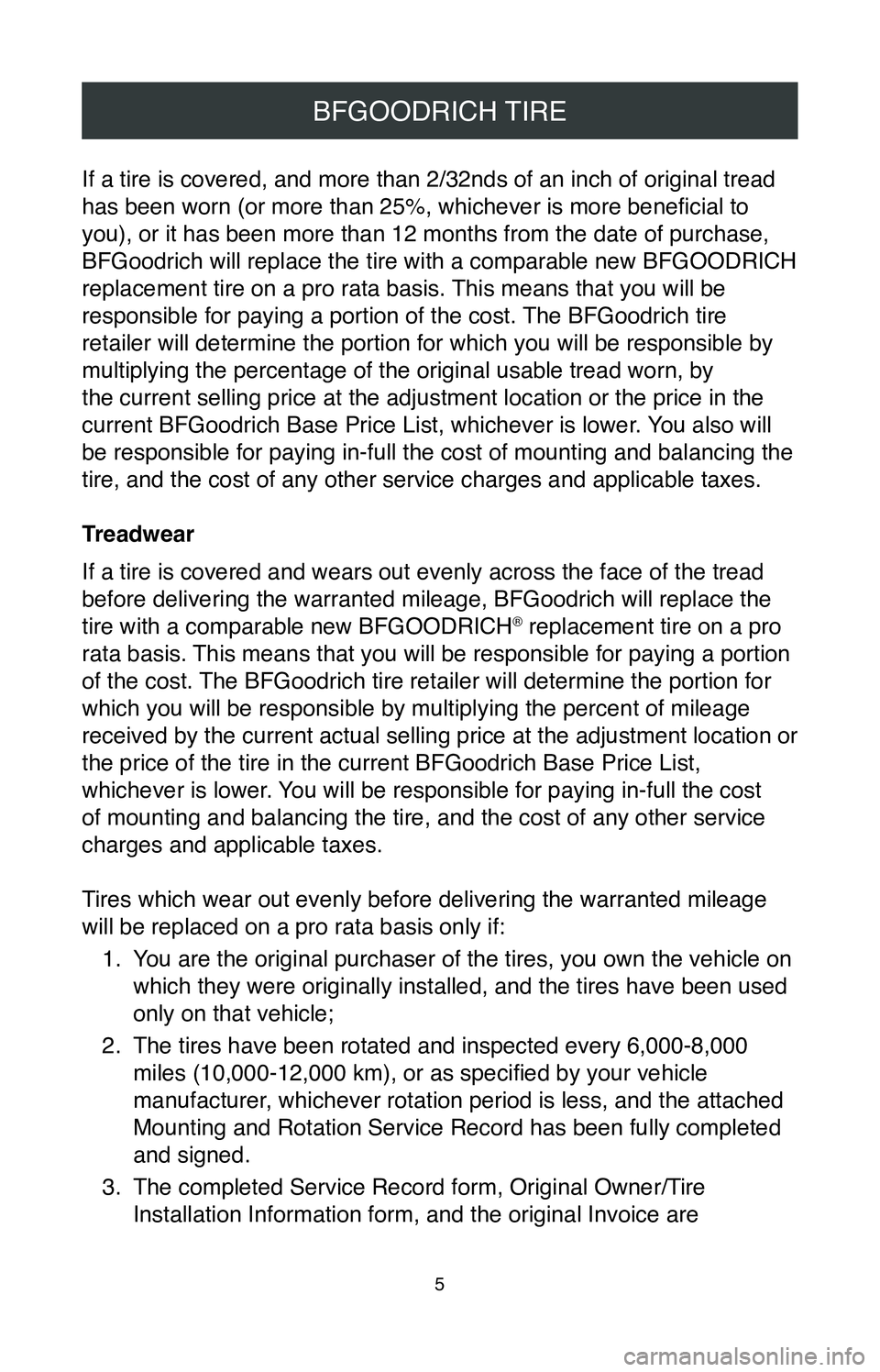
5
BFGOODRICH TIRE
If a tire is covered, and more than 2/32nds of an inch of original tread\
has been worn (or more than 25%, whichever is more beneficial to
you), or it has been more than 12 months from the date of purchase,
BFGoodrich will replace the tire with a comparable new BFGOODRICH
replacement tire on a pro rata basis. This means that you will be
responsible for paying a portion of the cost. The BFGoodrich tire
retailer will determine the portion for which you will be responsible by\
multiplying the percentage of the original usable tread worn, by
the current selling price at the adjustment location or the price in the
current BFGoodrich Base Price List, whichever is lower. You also will
be responsible for paying in-full the cost of mounting and balancing the
tire, and the cost of any other service charges and applicable taxes.
Treadwear
If a tire is covered and wears out evenly across the face of the tread
before delivering the warranted mileage, BFGoodrich will replace the
tire with a comparable new BFGOODRICH
® replacement tire on a pro
rata basis. This means that you will be responsible for paying a portion
of the cost. The BFGoodrich tire retailer will determine the portion for
which you will be responsible by multiplying the percent of mileage
received by the current actual selling price at the adjustment location or
the price of the tire in the current BFGoodrich Base Price List,
whichever is lower. You will be responsible for paying in-full the cost
of mounting and balancing the tire, and the cost of any other service
charges and applicable taxes.
Tires which wear out evenly before delivering the warranted mileage
will be replaced on a pro rata basis only if:
1.
You are the original purchaser of the tires, you own the vehicle on
which they were originally installed, and the tires have been used
only on that vehicle;
2.
The tires have been rotated and inspected every 6,000-8,000
miles (10,000-12,000 km), or as specified by your vehicle
manufacturer, whichever rotation period is less, and the attached
Mounting and Rotation Service Record has been fully completed
and signed.
3.
The completed Service Record form, Original Owner/Tire
Installation Information form, and the original Invoice are
Page 8 of 260
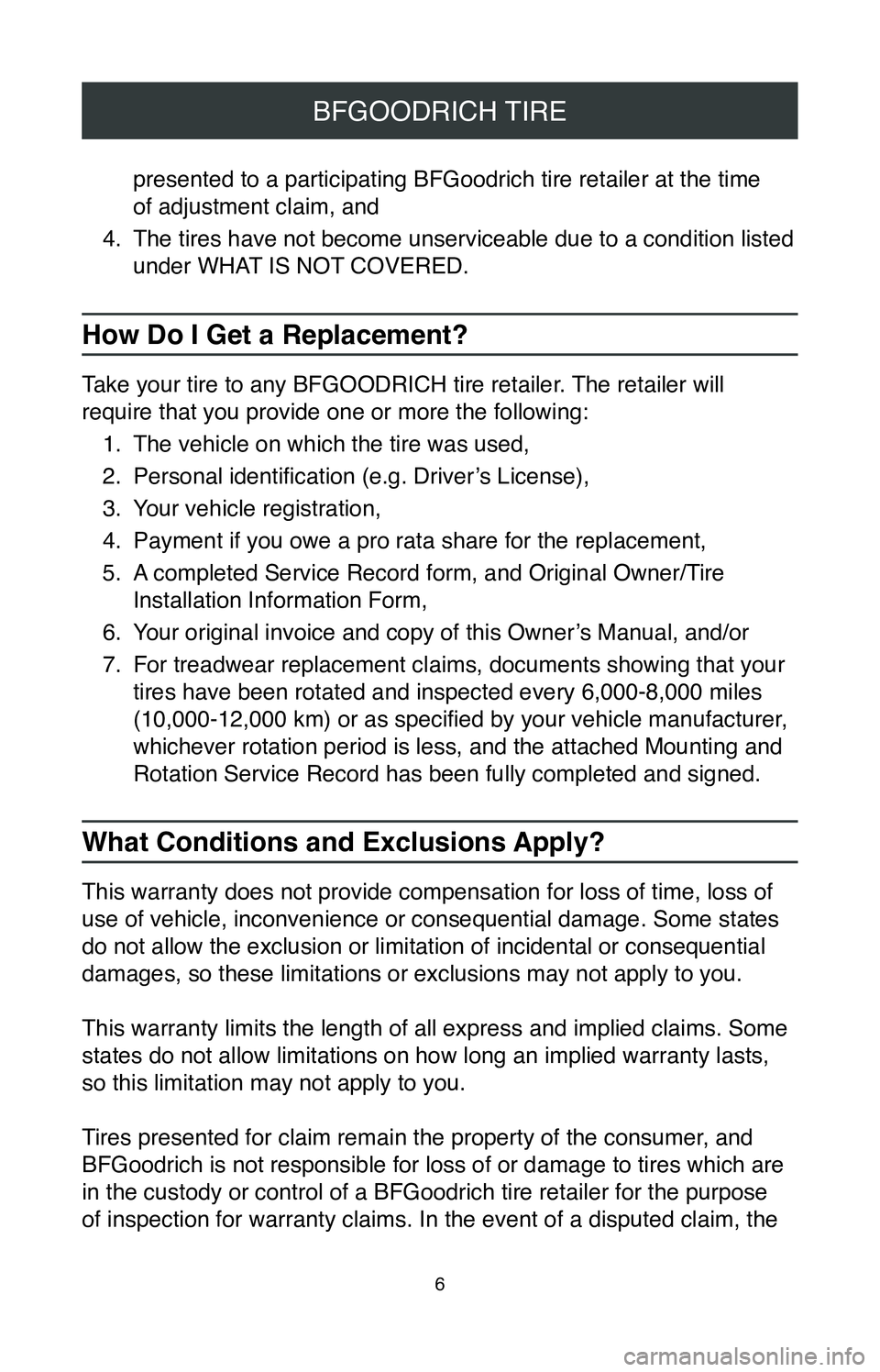
6
BFGOODRICH TIRE
presented to a participating BFGoodrich tire retailer at the time
of adjustment claim, and
4.
The tires have not become unserviceable due to a condition listed
under WHAT IS NOT COVERED.
How Do I Get a Replacement?
Take your tire to any BFGOODRICH tire retailer. The retailer will
require that you provide one or more the following: 1.
The vehicle on which the tire was used,
2.
Personal identification (e.g. Driver’s License),
3.
Your vehicle registration,
4.
Payment if you owe a pro rata share for the replacement,
5.
A completed Service Record form, and Original Owner/Tire
Installation Information Form,
6.
Your original invoice and copy of this Owner’s Manual, and/or
7.
For treadwear replacement claims, documents showing that your
tires have been rotated and inspected every 6,000-8,000 miles
(10,000-12,000 km) or as specified by your vehicle manufacturer,
whichever rotation period is less, and the attached Mounting and
Rotation Service Record has been fully completed and signed.
What Conditions and Exclusions Apply?
This warranty does not provide compensation for loss of time, loss of
use of vehicle, inconvenience or consequential damage. Some states
do not allow the exclusion or limitation of incidental or consequential \
damages, so these limitations or exclusions may not apply to you.
This warranty limits the length of all express and implied claims. Some \
states do not allow limitations on how long an implied warranty lasts,
so this limitation may not apply to you.
Tires presented for claim remain the property of the consumer, and
BFGoodrich is not responsible for loss of or damage to tires which are
in the custody or control of a BFGoodrich tire retailer for the purpose \
of inspection for warranty claims. In the event of a disputed claim, the\
Page 10 of 260
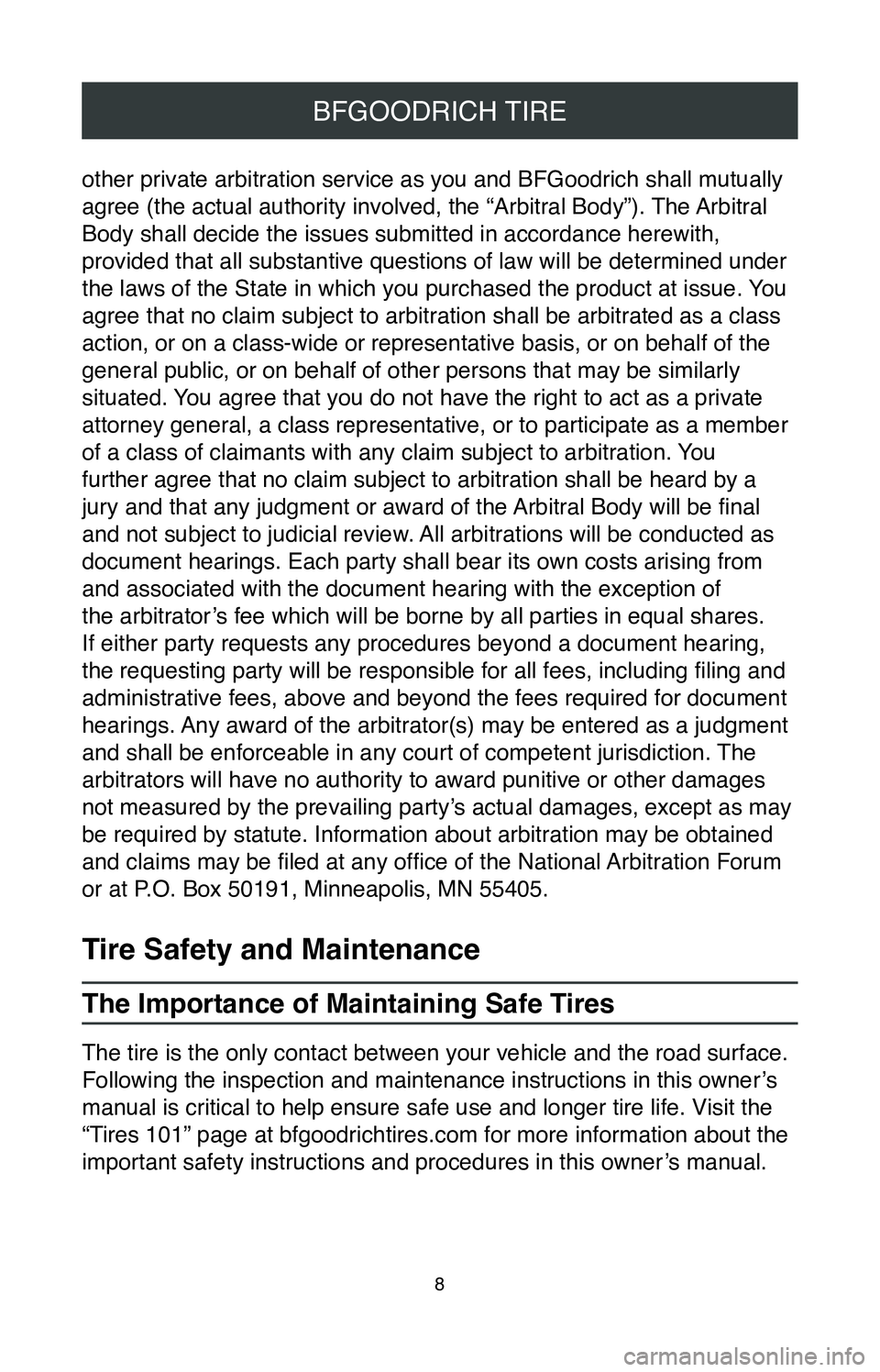
8
BFGOODRICH TIRE
other private arbitration service as you and BFGoodrich shall mutually
agree (the actual authority involved, the “Arbitral Body”). The Arbitral
Body shall decide the issues submitted in accordance herewith,
provided that all substantive questions of law will be determined under \
the laws of the State in which you purchased the product at issue. You
agree that no claim subject to arbitration shall be arbitrated as a class
action, or on a class-wide or representative basis, or on behalf of the
general public, or on behalf of other persons that may be similarly
situated. You agree that you do not have the right to act as a private
attorney general, a class representative, or to participate as a member \
of a class of claimants with any claim subject to arbitration. You
further agree that no claim subject to arbitration shall be heard by a
jury and that any judgment or award of the Arbitral Body will be final
and not subject to judicial review. All arbitrations will be conducted as
document hearings. Each party shall bear its own costs arising from
and associated with the document hearing with the exception of
the arbitrator’s fee which will be borne by all parties in equal shares.
If either party requests any procedures beyond a document hearing,
the requesting party will be responsible for all fees, including filing and
administrative fees, above and beyond the fees required for document
hearings. Any award of the arbitrator(s) may be entered as a judgment
and shall be enforceable in any court of competent jurisdiction. The
arbitrators will have no authority to award punitive or other damages
not measured by the prevailing party’s actual damages, except as may
be required by statute. Information about arbitration may be obtained
and claims may be filed at any office of the National Arbitration Forum
or at P.O. Box 50191, Minneapolis, MN 55405.
Tire Safety and Maintenance
The Importance of Maintaining Safe Tires
The tire is the only contact between your vehicle and the road surface. \
Following the inspection and maintenance instructions in this owner ’s
manual is critical to help ensure safe use and longer tire life. Visit the
“Tires 101” page at bfgoodrichtires.com for more information about the \
important safety instructions and procedures in this owner’s manual.
Page 14 of 260
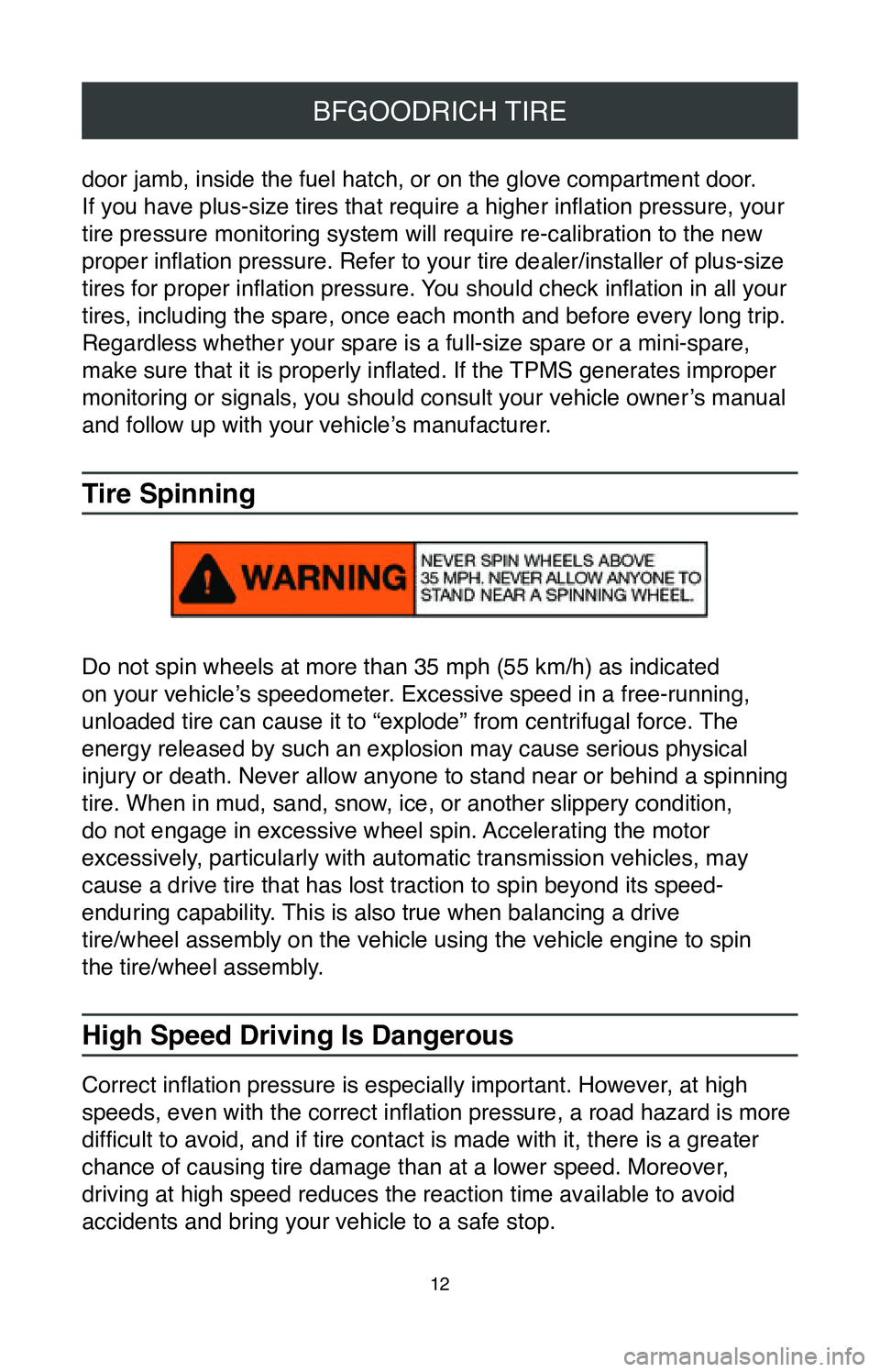
12
BFGOODRICH TIRE
door jamb, inside the fuel hatch, or on the glove compartment door.
If you have plus-size tires that require a higher inflation pressure, your
tire pressure monitoring system will require re-calibration to the new
proper inflation pressure. Refer to your tire dealer/installer of plus-size
tires for proper inflation pressure. You should check inflation in all your
tires, including the spare, once each month and before every long trip. \
Regardless whether your spare is a full-size spare or a mini-spare,
make sure that it is properly inflated. If the TPMS generates improper
monitoring or signals, you should consult your vehicle owner’s manual
and follow up with your vehicle’s manufacturer.
Tire Spinning
Do not spin wheels at more than 35 mph (55 km/h) as indicated
on your vehicle’s speedometer. Excessive speed in a free-running,
unloaded tire can cause it to “explode” from centrifugal force. The
energy released by such an explosion may cause serious physical
injury or death. Never allow anyone to stand near or behind a spinning
tire. When in mud, sand, snow, ice, or another slippery condition,
do not engage in excessive wheel spin. Accelerating the motor
excessively, particularly with automatic transmission vehicles, may
cause a drive tire that has lost traction to spin beyond its speed-
enduring capability. This is also true when balancing a drive
tire/wheel assembly on the vehicle using the vehicle engine to spin
the tire/wheel assembly.
High Speed Driving Is Dangerous
Correct inflation pressure is especially important. However, at high
speeds, even with the correct inflation pressure, a road hazard is more
difficult to avoid, and if tire contact is made with it, there is a greater
chance of causing tire damage than at a lower speed. Moreover,
driving at high speed reduces the reaction time available to avoid
accidents and bring your vehicle to a safe stop.
Page 17 of 260
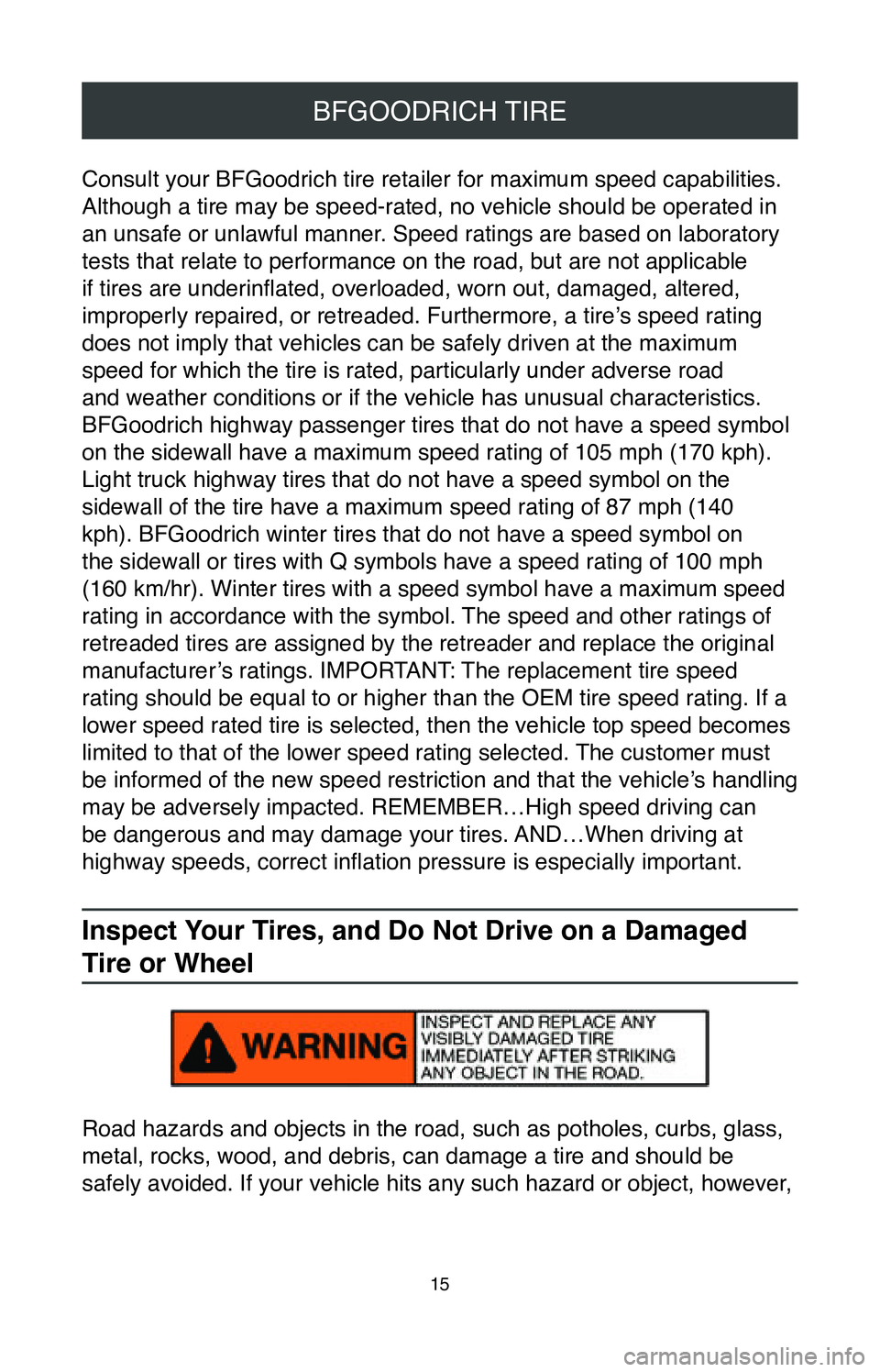
15
BFGOODRICH TIRE
Consult your BFGoodrich tire retailer for maximum speed capabilities.
Although a tire may be speed-rated, no vehicle should be operated in
an unsafe or unlawful manner. Speed ratings are based on laboratory
tests that relate to performance on the road, but are not applicable
if tires are underinflated, overloaded, worn out, damaged, altered,
improperly repaired, or retreaded. Furthermore, a tire’s speed rating
does not imply that vehicles can be safely driven at the maximum
speed for which the tire is rated, particularly under adverse road
and weather conditions or if the vehicle has unusual characteristics.
BFGoodrich highway passenger tires that do not have a speed symbol
on the sidewall have a maximum speed rating of 105 mph (170 kph).
Light truck highway tires that do not have a speed symbol on the
sidewall of the tire have a maximum speed rating of 87 mph (140
kph). BFGoodrich winter tires that do not have a speed symbol on
the sidewall or tires with Q symbols have a speed rating of 100 mph
(160 km/hr). Winter tires with a speed symbol have a maximum speed
rating in accordance with the symbol. The speed and other ratings of
retreaded tires are assigned by the retreader and replace the original
manufacturer’s ratings. IMPORTANT: The replacement tire speed
rating should be equal to or higher than the OEM tire speed rating. If a\
lower speed rated tire is selected, then the vehicle top speed becomes
limited to that of the lower speed rating selected. The customer must
be informed of the new speed restriction and that the vehicle’s handling
may be adversely impacted. REMEMBER…High speed driving can
be dangerous and may damage your tires. AND…When driving at
highway speeds, correct inflation pressure is especially important.
Inspect Your Tires, and Do Not Drive on a Damaged
Tire or Wheel
Road hazards and objects in the road, such as potholes, curbs, glass,
metal, rocks, wood, and debris, can damage a tire and should be
safely avoided. If your vehicle hits any such hazard or object, however,
Page 25 of 260
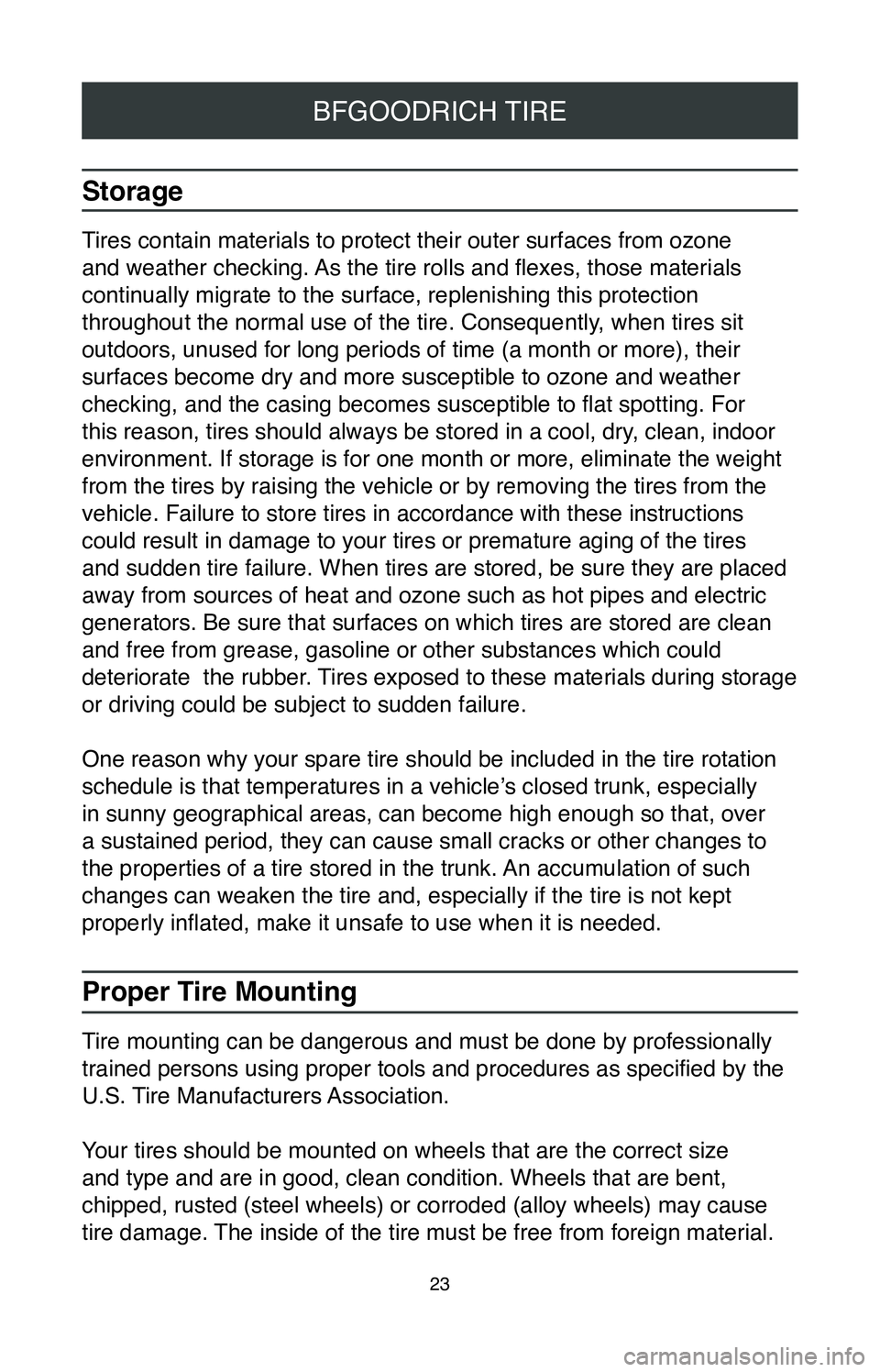
23
BFGOODRICH TIRE
Storage
Tires contain materials to protect their outer surfaces from ozone
and weather checking. As the tire rolls and flexes, those materials
continually migrate to the surface, replenishing this protection
throughout the normal use of the tire. Consequently, when tires sit
outdoors, unused for long periods of time (a month or more), their
surfaces become dry and more susceptible to ozone and weather
checking, and the casing becomes susceptible to flat spotting. For
this reason, tires should always be stored in a cool, dry, clean, indoor
environment. If storage is for one month or more, eliminate the weight
from the tires by raising the vehicle or by removing the tires from the \
vehicle. Failure to store tires in accordance with these instructions
could result in damage to your tires or premature aging of the tires
and sudden tire failure. When tires are stored, be sure they are placed \
away from sources of heat and ozone such as hot pipes and electric
generators. Be sure that surfaces on which tires are stored are clean
and free from grease, gasoline or other substances which could
deteriorate the rubber. Tires exposed to these materials during storage
or driving could be subject to sudden failure.
One reason why your spare tire should be included in the tire rotation
schedule is that temperatures in a vehicle’s closed trunk, especially
in sunny geographical areas, can become high enough so that, over
a sustained period, they can cause small cracks or other changes to
the properties of a tire stored in the trunk. An accumulation of such
changes can weaken the tire and, especially if the tire is not kept
properly inflated, make it unsafe to use when it is needed.
Proper Tire Mounting
Tire mounting can be dangerous and must be done by professionally
trained persons using proper tools and procedures as specified by the
U.S. Tire Manufacturers Association.
Your tires should be mounted on wheels that are the correct size
and type and are in good, clean condition. Wheels that are bent,
chipped, rusted (steel wheels) or corroded (alloy wheels) may cause
tire damage. The inside of the tire must be free from foreign material.
Page 32 of 260
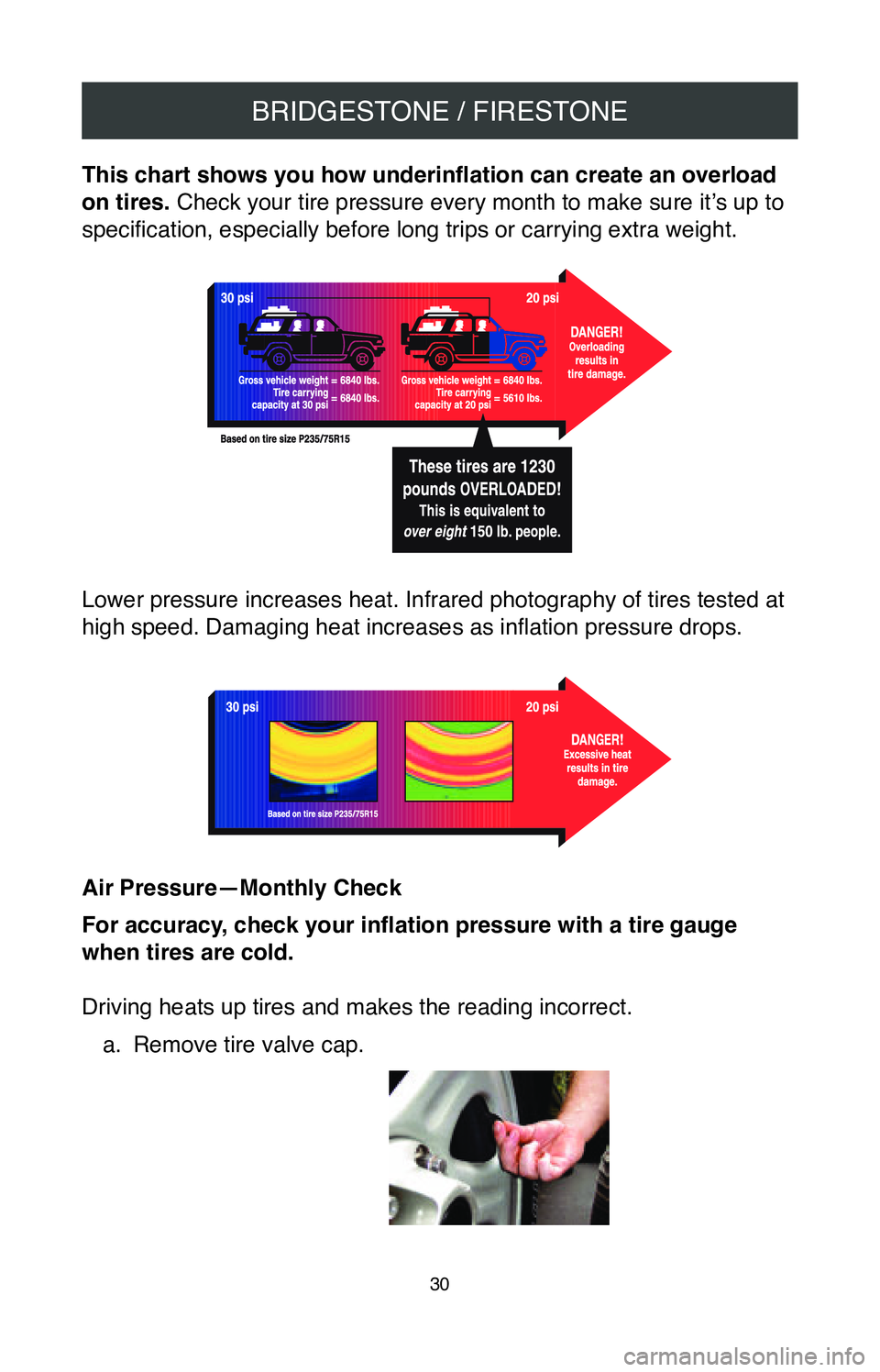
BRIDGESTONE / FIRESTONE
30
This chart shows you how underinflation can create an overload
on tires. Check your tire pressure every month to make sure it’s up to
specification, especially before long trips or carrying extra weight.
Lower pressure increases heat. Infrared photography of tires tested at
high speed. Damaging heat increases as inflation pressure drops.
Air Pressure—Monthly Check
For accuracy, check your inflation pressure with a tire gauge
when tires are cold.
Driving heats up tires and makes the reading incorrect.a.
Remove tire valve cap.
Page 44 of 260
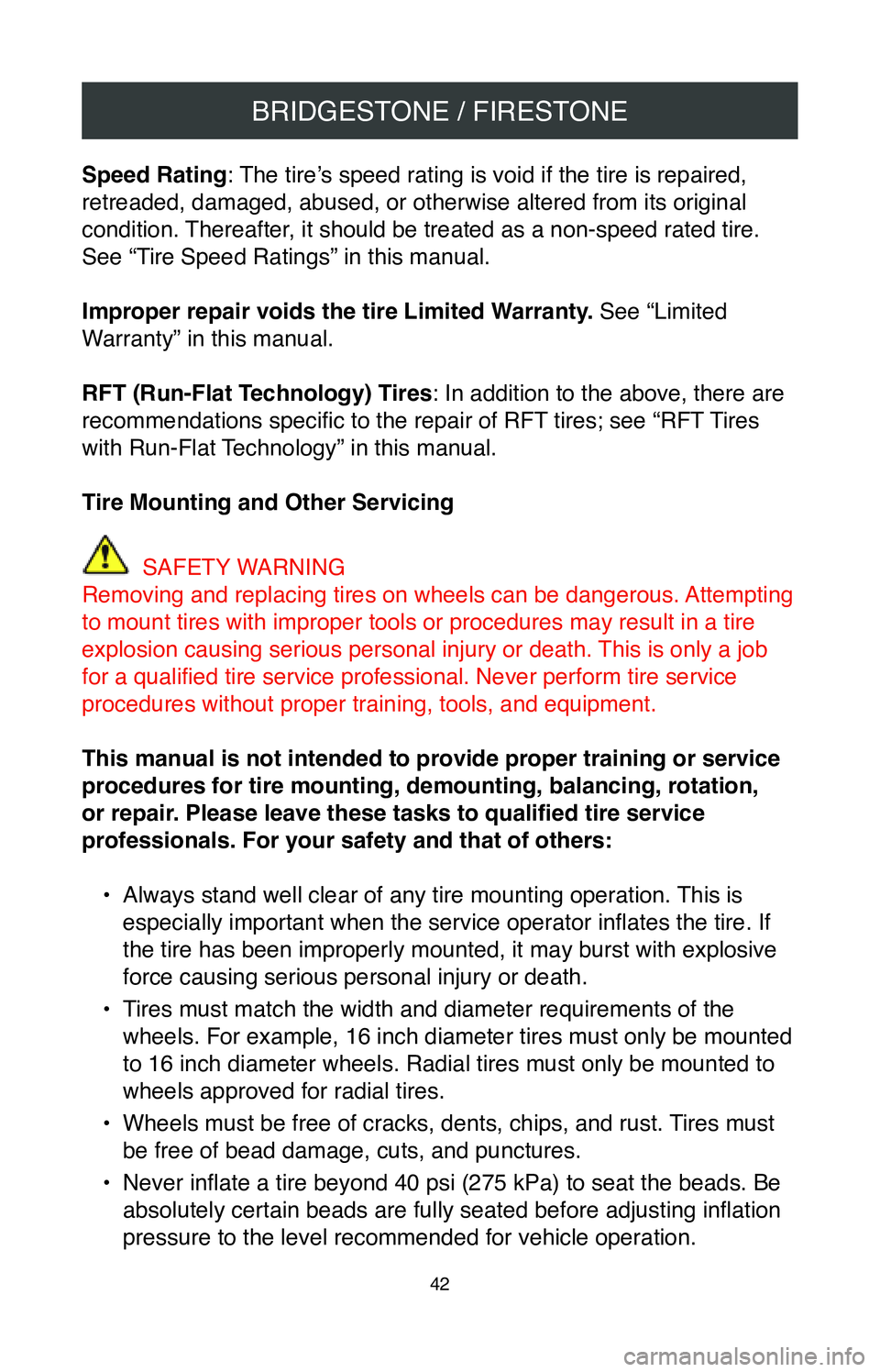
BRIDGESTONE / FIRESTONE
42
Speed Rating: The tire’s speed rating is void if the tire is repaired,
retreaded, damaged, abused, or otherwise altered from its original
condition. Thereafter, it should be treated as a non-speed rated tire.
See “Tire Speed Ratings” in this manual.
Improper repair voids the tire Limited Warranty. See “Limited
Warranty” in this manual.
RFT (Run-Flat Technology) Tires: In addition to the above, there are
recommendations specific to the repair of RFT tires; see “RFT Tires
with Run-Flat Technology” in this manual.
Tire Mounting and Other Servicing
SAFETY WARNING
Removing and replacing tires on wheels can be dangerous. Attempting
to mount tires with improper tools or procedures may result in a tire
explosion causing serious personal injury or death. This is only a job
for a qualified tire service professional. Never perform tire service
procedures without proper training, tools, and equipment.
This manual is not intended to provide proper training or service
procedures for tire mounting, demounting, balancing, rotation,
or repair. Please leave these tasks to qualified tire service
professionals. For your safety and that of others:
•
Always stand well clear of any tire mounting operation. This is
especially important when the service operator inflates the tire. If
the tire has been improperly mounted, it may burst with explosive
force causing serious personal injury or death.
•
Tires must match the width and diameter requirements of the
wheels. For example, 16 inch diameter tires must only be mounted
to 16 inch diameter wheels. Radial tires must only be mounted to
wheels approved for radial tires.
•
Wheels must be free of cracks, dents, chips, and rust. Tires must
be free of bead damage, cuts, and punctures.
•
Never inflate a tire beyond 40 psi (275 kPa) to seat the beads. Be
absolutely certain beads are fully seated before adjusting inflation
pressure to the level recommended for vehicle operation.
Page 46 of 260
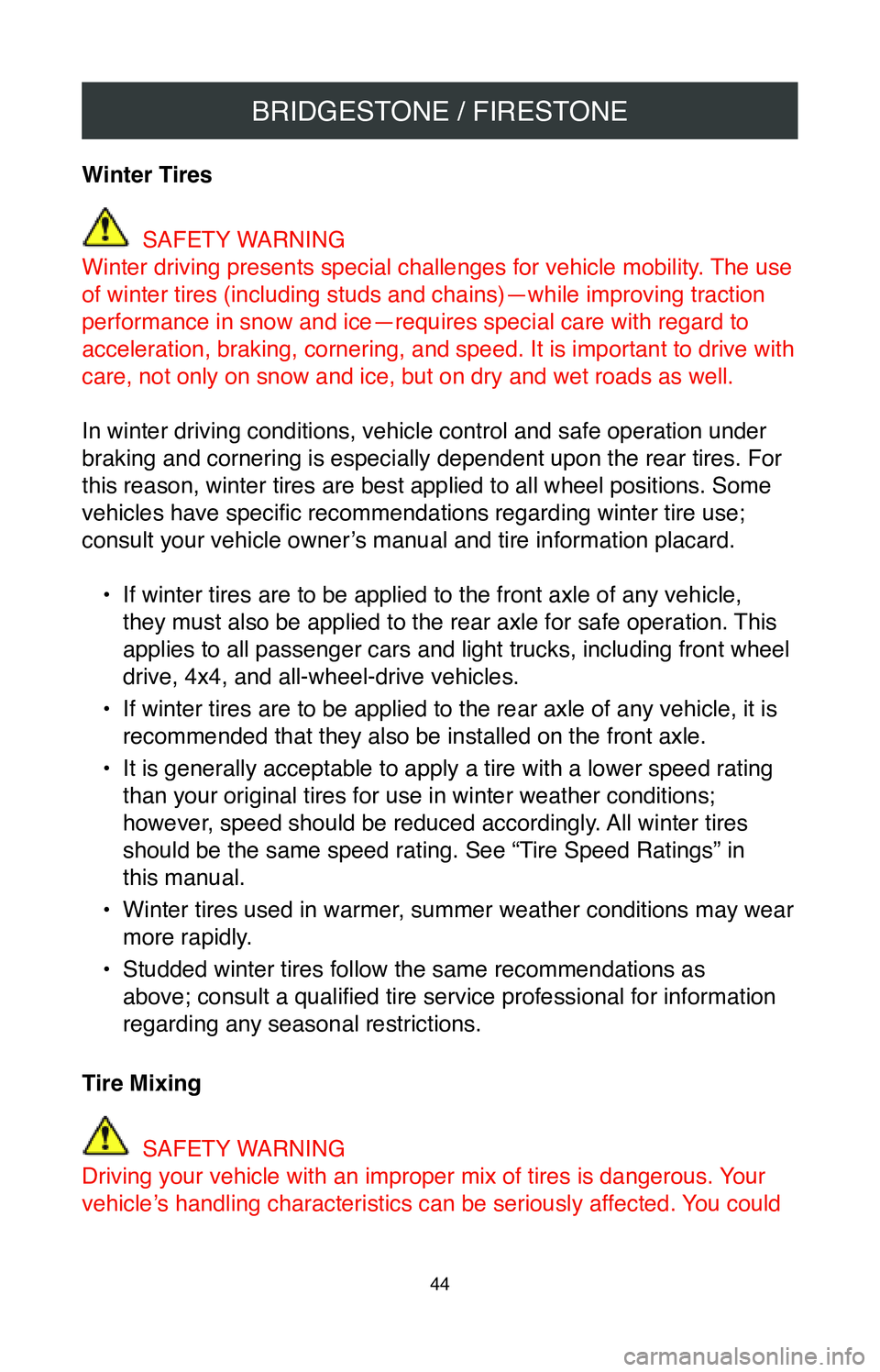
BRIDGESTONE / FIRESTONE
44
Winter Tires
SAFETY WARNING
Winter driving presents special challenges for vehicle mobility. The use
of winter tires (including studs and chains)—while improving traction
performance in snow and ice—requires special care with regard to
acceleration, braking, cornering, and speed. It is important to drive wi\
th
care, not only on snow and ice, but on dry and wet roads as well.
In winter driving conditions, vehicle control and safe operation under
braking and cornering is especially dependent upon the rear tires. For
this reason, winter tires are best applied to all wheel positions. Some \
vehicles have specific recommendations regarding winter tire use;
consult your vehicle owner’s manual and tire information placard.
•
If winter tires are to be applied to the front axle of any vehicle,
they must also be applied to the rear axle for safe operation. This
applies to all passenger cars and light trucks, including front wheel
drive, 4x4, and all-wheel-drive vehicles.
•
If winter tires are to be applied to the rear axle of any vehicle, it is\
recommended that they also be installed on the front axle.
•
It is generally acceptable to apply a tire with a lower speed rating
than your original tires for use in winter weather conditions;
however, speed should be reduced accordingly. All winter tires
should be the same speed rating. See “Tire Speed Ratings” in
this manual.
•
Winter tires used in warmer, summer weather conditions may wear
more rapidly.
•
Studded winter tires follow the same recommendations as
above; consult a qualified tire service professional for information
regarding any seasonal restrictions.
Tire Mixing
SAFETY WARNING
Driving your vehicle with an improper mix of tires is dangerous. Your
vehicle’s handling characteristics can be seriously affected. You could
Page 61 of 260
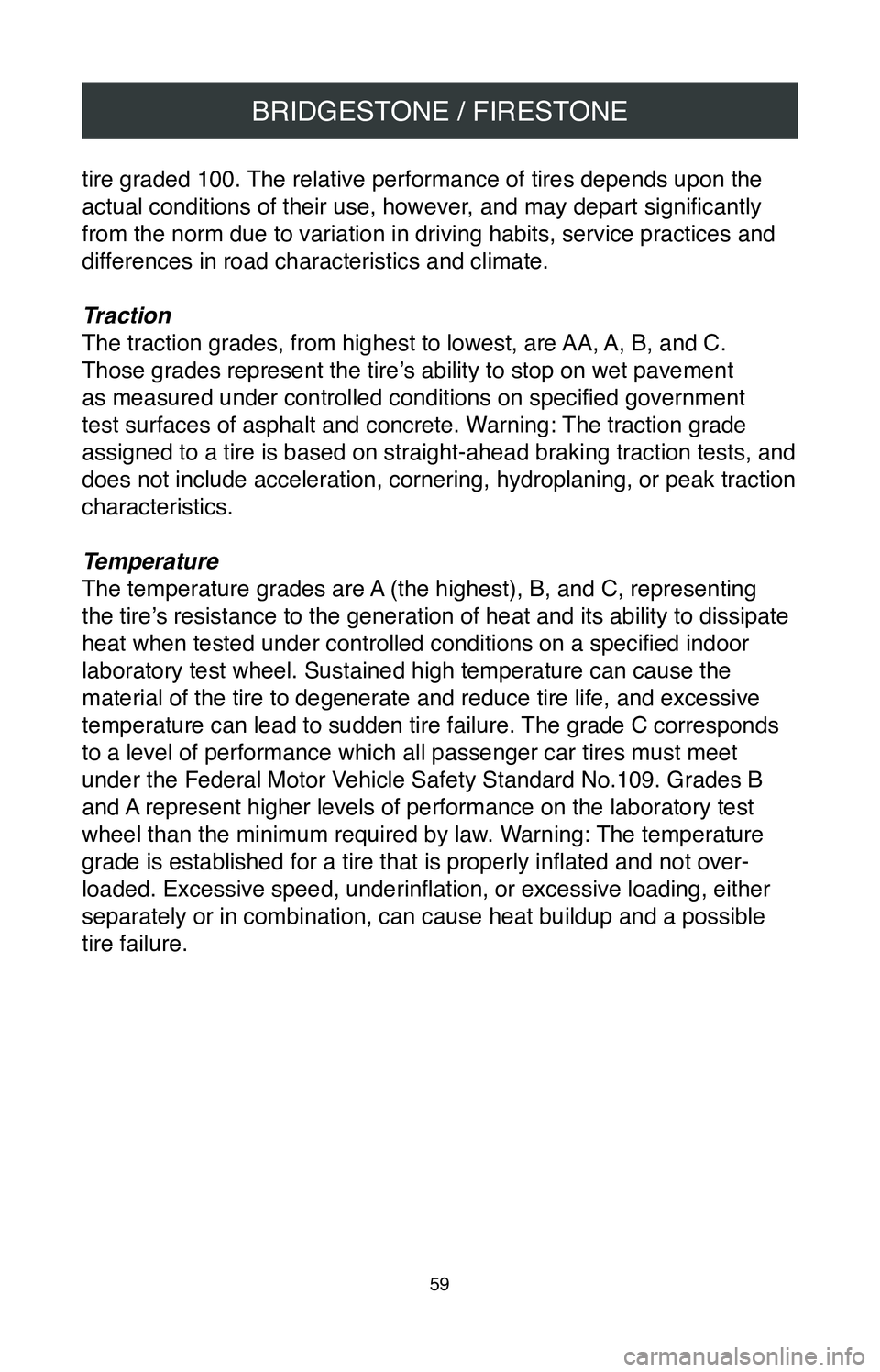
BRIDGESTONE / FIRESTONE
59
tire graded 100. The relative performance of tires depends upon the
actual conditions of their use, however, and may depart significantly
from the norm due to variation in driving habits, service practices and \
differences in road characteristics and climate.
Traction
The traction grades, from highest to lowest, are AA, A, B, and C.
Those grades represent the tire’s ability to stop on wet pavement
as measured under controlled conditions on specified government
test surfaces of asphalt and concrete. Warning: The traction grade
assigned to a tire is based on straight-ahead braking traction tests, and
does not include acceleration, cornering, hydroplaning, or peak traction\
characteristics.
Temperature
The temperature grades are A (the highest), B, and C, representing
the tire’s resistance to the generation of heat and its ability to dissipate
heat when tested under controlled conditions on a specified indoor
laboratory test wheel. Sustained high temperature can cause the
material of the tire to degenerate and reduce tire life, and excessive
temperature can lead to sudden tire failure. The grade C corresponds
to a level of performance which all passenger car tires must meet
under the Federal Motor Vehicle Safety Standard No.109. Grades B
and A represent higher levels of performance on the laboratory test
wheel than the minimum required by law. Warning: The temperature
grade is established for a tire that is properly inflated and not over-
loaded. Excessive speed, underinflation, or excessive loading, either
separately or in combination, can cause heat buildup and a possible
tire failure.